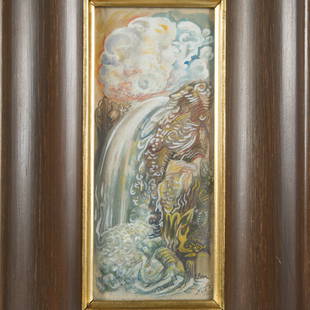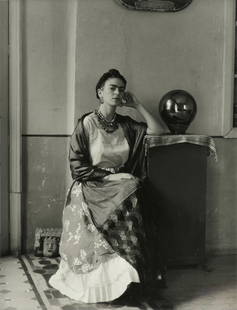
MANUEL ALVAREZ BRAVO, SIGNS AND PROGNOSTICATIONS, 1938
Manuel Alvarez Bravo Sale History
View Price Results for Manuel Alvarez BravoRelated Photography
More Items in Mexican Photography
View MoreRecommended Art
View More


Item Details
Description
MANUEL ALVAREZ BRAVO (1902-2002), SIGNS AND PROGNOSTICATIONS, (SENALES Y PRONÓSTICOS),1938 gelatin silver print, printed early 1970s, ed. 3/99; 9 x 6 1/2 in. (image); signed, numbered verso. Condition: Excellent. MAB-0006
CONDITION: For a condition report, please email info@ethertongallery.com.
Frames when illustrated, are for reference ONLY and are not included with the lot. Please note that the color and tonality of digital references may vary. Titles, dates, details and descriptions are for guidance only and are subject to change.
MANUEL ALVAREZ BRAVO
Considered Mexico’s greatest photographer, Manuel ?lvarez Bravo is best known for the longevity of a career that defined Mexican modernism. Bravo came of age in the period following the Mexican Revolution, which inaugurated a cultural search for a unique national identity. Bravo’s contribution was to create deceptively simple photographs that fused the vocabulary of European modernism with a celebration of everyday life in Mexico, imbued with mysticism and sensuality. Manuel ?lvarez Bravo was born in Mexico City February 4, 1902. His grandfather (a painter) and his father, were both amateur photographers. Bravo purchased his first camera at age twenty and gained dark room experience working for German photographer Hugo Brehme (1882-1954). Initially, Bravo embraced Pictorialism, but with the advent of cubism, he began to investigate the possibilities of straight photography. Bravo learned about European modernist photography, and practitioners as varied as Albert Renger Patzsch, Henri Cartier-Bresson, Tina Modotti and Edward Weston primarily through magazines. In 1927, he met Modotti who introduced him to the Mexican avant-garde muralists, Diego Rivera, David Alfaro Siqueiros, and José Clemente Orozco. They infused the vocabulary of European modernism with the search for an authentic Mexican identity rooted in socialist ideals. When Tina Modotti was deported from Mexico in 1930, Bravo took over her position as photographer for the magazine Mexican Folkways and frequently traveled through the countryside documenting customs, festivities, and folklore.
During the 1920s and 1930s, Bravo captured the complex cultural shifts and radical political changes taking place in Mexico, photographing the street scenes, signs, and storefronts of Mexico City. Photographs of vernacular subjects were imbued with a mystical symbolism that must also be read for their political significance. One of his most famous photographs, Striking Worker, Assassinated (1934) makes overt social commentary on the tumultuous period. Bravo 's photographs caught the attention of European Surrealists and André Breton, who commissioned an image for the cover of a catalog that accompanied a Surrealist exhibition at GalerÃa de Arte Méxicano. This commission produced Good Reputation Sleeping (1938), which features a naked woman lying on the sidewalk, surrounded by prickly star cacti. (The images were not used due to its front nudity.) The model's upper thighs, hips, waist, and feet are wrapped in bandages, exposing her pudendum. Over the years, Good Reputation Sleeping has become a visual short hand for Bravo’s career with its allusions to sexuality, the unconscious, and the lack of free will.
While well-known in Europe, Bravo’s work was not recognized in the United States until later in his career. A meeting with Edward Weston (1886-1958), led to an exhibition at the Berkeley Art Museum with Weston, Imogen Cunningham (1883-1976) and Dorothea Lange (1895-1965). A few years later, Bravo met photographers Paul Strand (1890-1976) and Henri Cartier-Bresson (1908-2004). Bravo exhibited with Cartier–Bresson in 1934 at the Palace of Fine Arts in Mexico City. In 1935, the two exhibited again with Walker Evans (1903-1975) in an important exhibition at the Julien Levy Gallery, titled Documentary and Anti-Graphic Photographs. After this early notice, Bravo remained relatively anonymous in the United States until a 1971 exhibition at the Pasadena Art Museum in California, which traveled to New York’s Museum of Modern Art. Subsequent exhibitions at the Corcoran Gallery of Art in Washington D.C. (1978) and San Diego’s Museum of Photographic Arts (1990) helped secure his reputation. However, his place in the history of photography was secured when he returned to MOMA in 1997 for a definitive retrospective of 175 photographs. In his lifetime Bravo participated in over 300 exhibitions at galleries and museums all over the world. In 1997 The Museum of Modern Art held a major retrospective exhibition featuring photographs from a career of almost 80 years, including his color photography and platinum printing from the 1960s and 1970s. Bravo continued making pictures through the 1990s. In 2002, he died at the age of 100.
Manuel Alvarez Bravo’s work is in museum collections around the world, including The Museum of Modern Art, the San Francisco Museum of Modern Art, the Metropolitan Museum of Art, the J. Paul Getty Museum, the Victoria and Albert Museum, Bibliothèque Nationale de France, Museo de Arte Moderno, Mexico City, the George Eastman House, the Center for Creative Photography, and many others.
CONDITION: For a condition report, please email info@ethertongallery.com.
Frames when illustrated, are for reference ONLY and are not included with the lot. Please note that the color and tonality of digital references may vary. Titles, dates, details and descriptions are for guidance only and are subject to change.
MANUEL ALVAREZ BRAVO
Considered Mexico’s greatest photographer, Manuel ?lvarez Bravo is best known for the longevity of a career that defined Mexican modernism. Bravo came of age in the period following the Mexican Revolution, which inaugurated a cultural search for a unique national identity. Bravo’s contribution was to create deceptively simple photographs that fused the vocabulary of European modernism with a celebration of everyday life in Mexico, imbued with mysticism and sensuality. Manuel ?lvarez Bravo was born in Mexico City February 4, 1902. His grandfather (a painter) and his father, were both amateur photographers. Bravo purchased his first camera at age twenty and gained dark room experience working for German photographer Hugo Brehme (1882-1954). Initially, Bravo embraced Pictorialism, but with the advent of cubism, he began to investigate the possibilities of straight photography. Bravo learned about European modernist photography, and practitioners as varied as Albert Renger Patzsch, Henri Cartier-Bresson, Tina Modotti and Edward Weston primarily through magazines. In 1927, he met Modotti who introduced him to the Mexican avant-garde muralists, Diego Rivera, David Alfaro Siqueiros, and José Clemente Orozco. They infused the vocabulary of European modernism with the search for an authentic Mexican identity rooted in socialist ideals. When Tina Modotti was deported from Mexico in 1930, Bravo took over her position as photographer for the magazine Mexican Folkways and frequently traveled through the countryside documenting customs, festivities, and folklore.
During the 1920s and 1930s, Bravo captured the complex cultural shifts and radical political changes taking place in Mexico, photographing the street scenes, signs, and storefronts of Mexico City. Photographs of vernacular subjects were imbued with a mystical symbolism that must also be read for their political significance. One of his most famous photographs, Striking Worker, Assassinated (1934) makes overt social commentary on the tumultuous period. Bravo 's photographs caught the attention of European Surrealists and André Breton, who commissioned an image for the cover of a catalog that accompanied a Surrealist exhibition at GalerÃa de Arte Méxicano. This commission produced Good Reputation Sleeping (1938), which features a naked woman lying on the sidewalk, surrounded by prickly star cacti. (The images were not used due to its front nudity.) The model's upper thighs, hips, waist, and feet are wrapped in bandages, exposing her pudendum. Over the years, Good Reputation Sleeping has become a visual short hand for Bravo’s career with its allusions to sexuality, the unconscious, and the lack of free will.
While well-known in Europe, Bravo’s work was not recognized in the United States until later in his career. A meeting with Edward Weston (1886-1958), led to an exhibition at the Berkeley Art Museum with Weston, Imogen Cunningham (1883-1976) and Dorothea Lange (1895-1965). A few years later, Bravo met photographers Paul Strand (1890-1976) and Henri Cartier-Bresson (1908-2004). Bravo exhibited with Cartier–Bresson in 1934 at the Palace of Fine Arts in Mexico City. In 1935, the two exhibited again with Walker Evans (1903-1975) in an important exhibition at the Julien Levy Gallery, titled Documentary and Anti-Graphic Photographs. After this early notice, Bravo remained relatively anonymous in the United States until a 1971 exhibition at the Pasadena Art Museum in California, which traveled to New York’s Museum of Modern Art. Subsequent exhibitions at the Corcoran Gallery of Art in Washington D.C. (1978) and San Diego’s Museum of Photographic Arts (1990) helped secure his reputation. However, his place in the history of photography was secured when he returned to MOMA in 1997 for a definitive retrospective of 175 photographs. In his lifetime Bravo participated in over 300 exhibitions at galleries and museums all over the world. In 1997 The Museum of Modern Art held a major retrospective exhibition featuring photographs from a career of almost 80 years, including his color photography and platinum printing from the 1960s and 1970s. Bravo continued making pictures through the 1990s. In 2002, he died at the age of 100.
Manuel Alvarez Bravo’s work is in museum collections around the world, including The Museum of Modern Art, the San Francisco Museum of Modern Art, the Metropolitan Museum of Art, the J. Paul Getty Museum, the Victoria and Albert Museum, Bibliothèque Nationale de France, Museo de Arte Moderno, Mexico City, the George Eastman House, the Center for Creative Photography, and many others.
Condition
Excellent
Dimensions
8 x 10 in
Buyer's Premium
- 25% up to $100,000.00
- 20% above $100,000.00
MANUEL ALVAREZ BRAVO, SIGNS AND PROGNOSTICATIONS, 1938
Estimate $4,000 - $5,000
11 bidders are watching this item.
Get approved to bid.
Shipping & Pickup Options
Item located in Tucson, AZ, us$100 shipping in the US
Local Pickup Available
Payment
Accepts seamless payments through LiveAuctioneers

TOP





































![[OPERATION CASTLE - BRAVO TEST]. Photograph of the Castle Bravo test March 1, 1954 (printed 2009).: [OPERATION CASTLE - BRAVO TEST]. Photograph of the Castle Bravo test March 1, 1954 (but printed 2009). Visible area 16 x 20 in. color print on Harman fiber paper. Matted and framed (not examined out o](https://p1.liveauctioneers.com/197/329395/177650220_1_x.jpg?height=310&quality=70&version=1715364962)







![Store Exteriors Photos Akron, OH c1890-1910 (3) [180788]: A trio of photographs of store exteriors, c1890-1910. Includes The Factory Oil Co., with photographer's envelope from Stivas Studio, Akron, OH, 10" x 8" with border. Others included are: small store w](https://p1.liveauctioneers.com/2699/331499/178846584_1_x.jpg?height=310&quality=70&version=1717095214)











![Emilio Grau-Sala "Sur la Plage" Oil on Canvas: Emilio Grau-Sala (Spanish, 1911-1975), "Sur la Plage" [On The Beach], Oil on Canvas, 1958, signed "Grau Sala" lower right, signed, inscribed "Trouville", dated, and titled to verso. Image: 21.5" H x 2](https://p1.liveauctioneers.com/5649/328023/176731071_1_x.jpg?height=310&quality=70&version=1714409606)














